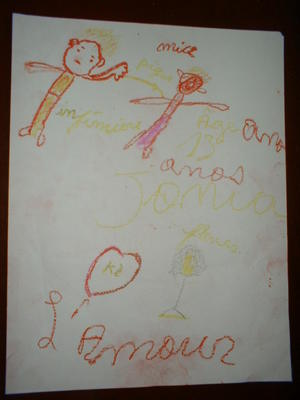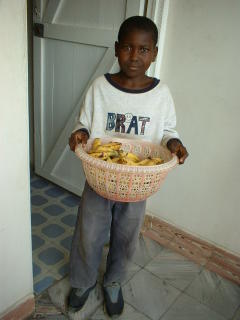Every Friday evening, I get together with Haitian kids who come to work in the bi-national market, at a small NGO office. We do arts and crafts activities, watch video, or just chat. Seeing Haitian children in the market, I wanted to do something. First I wanted to hear their voice. Upon consulting this NGO that works in the area of Haiti-DR cultural exchange, the staff kindly offered to provide an office space and trasnlation (Creole-Spanish).
10~15 children come each time, most of them being repeaters. There must be 50~60 Haitian children coming to the market, and the number seems to have been increasing lately.
When I arrived in the NGO office one day, there were already five children there. These children are more punctuate than Dominicans, although they do not carry watches.
As I was speaking with Milita, a 9-year old girl, I asked how much she earned today. She shly took out bills of 10 pesos (33 cents) from her waist-pouch. There were three bills. This is the earning of her day of work, selling plastic bags to the people who come to the market.

“Milta, the opportunity cost of your not going to school for one day is more than 30 pesos,” I wanted to say. She would not get what I say, or even if she did, it’s very unlikely that she would be enrolled in school. In Haiti, public primary education is free, but in order to go to school, one needs notebooks, pencils, clothing, etc. and the majority cannot afford to buy them.
In the past, I asked them to draw “what I want to be in the future.” A nurse was popular among girls, and a musician and a nurse among boys. After they finished drawing, I asked them what they needed to do in order to be what they want to be. ALL, responded, as if they were proud of knowing the answer to my question, “to go to school!”
Photo: Jonia, 13 years old, wants to be a nurse. In her drawing is a nurse giving an injection to a patient.ハイチ少年と少女金曜日の夕方、ハイチからダハボンのマーケットに働きに来る子どもたちと、地元NGOの小さなオフィスに集まり、一時間ほど絵を描いたりビデオを見たりする活動をしている。バナナやビニール袋を売り歩く子どもたちを目にし、何かできないか、それにはまず彼らの声を聞きたい、とこのNGOに話したところ、親切にも場所と通訳(クレオール語―スペイン語)提供をしてくれることになった。
たいていきまった顔ぶれの子どもたちが10~15人やってくる。マーケットにいる子どもの数は少なくとも50~60人、最近増えてきている気がする。
その日私がNGOオフィスに着くと、すでに5人の子どもが来ていた。彼らは時計を持っていないにも関わらず、ドミニカ人より時間に正確だ。
9歳のMilitaという女の子と話し始めた。その日の稼ぎを聞くと、ウエストポーチからくしゃくしゃの10ペソ札(33円)を恥ずかしそうに取り出して見せてくれた。3枚あった。朝から夕方までビニール袋を売り歩いた売り上げだ。

「Milita、一日学校に行かないことの機会費用は30ペソ以上なんだよ」、と言っても理解してもらえないし、分かってもらえたところで学校に行ける確率は低い。Militaは学校に行きたいと言うが、お金がなくて行けない。ハイチ公立学校の授業料はゼロだが、学校に行くとなるとノートや鉛筆、洋服を買わなければならず、そのお金がないのである。
以前彼らに「将来なりたいもの」の絵を描いてもらったことがある。女の子の多くが看護婦、男の子はミュージシャンや看護婦になりたいそうだ。「じゃあ、何をしたら、なりたいものになれるの?」と聞くと、答えを知っているかのように誇らしげに、全員が「学校に行くこと!」と答えた。



